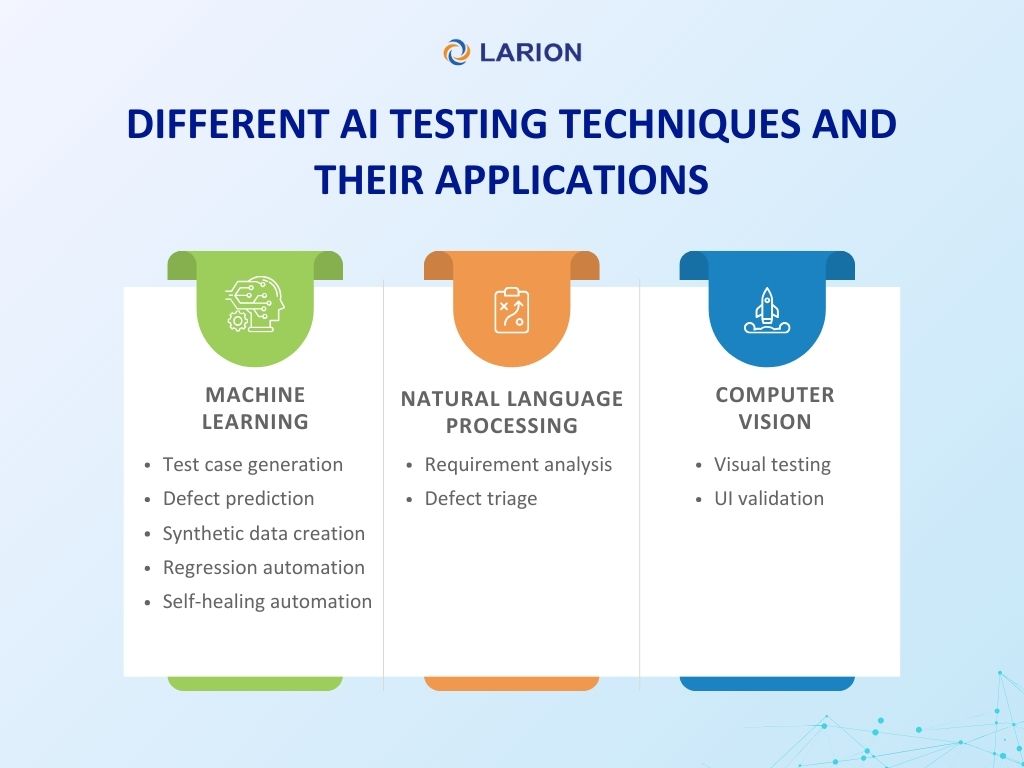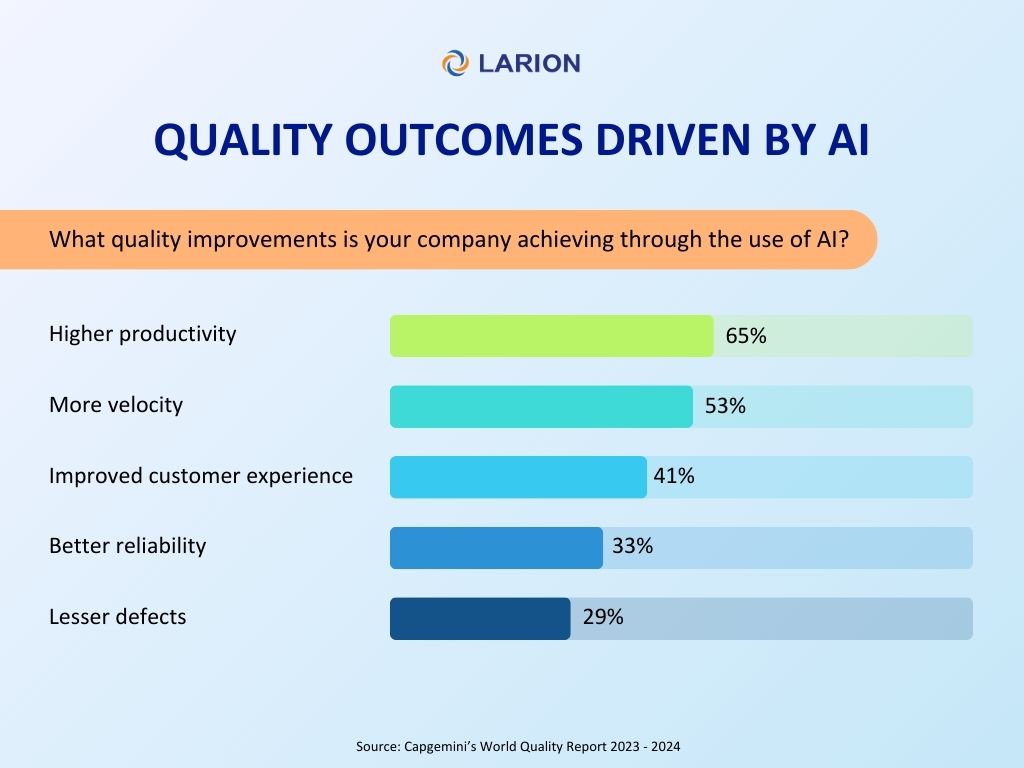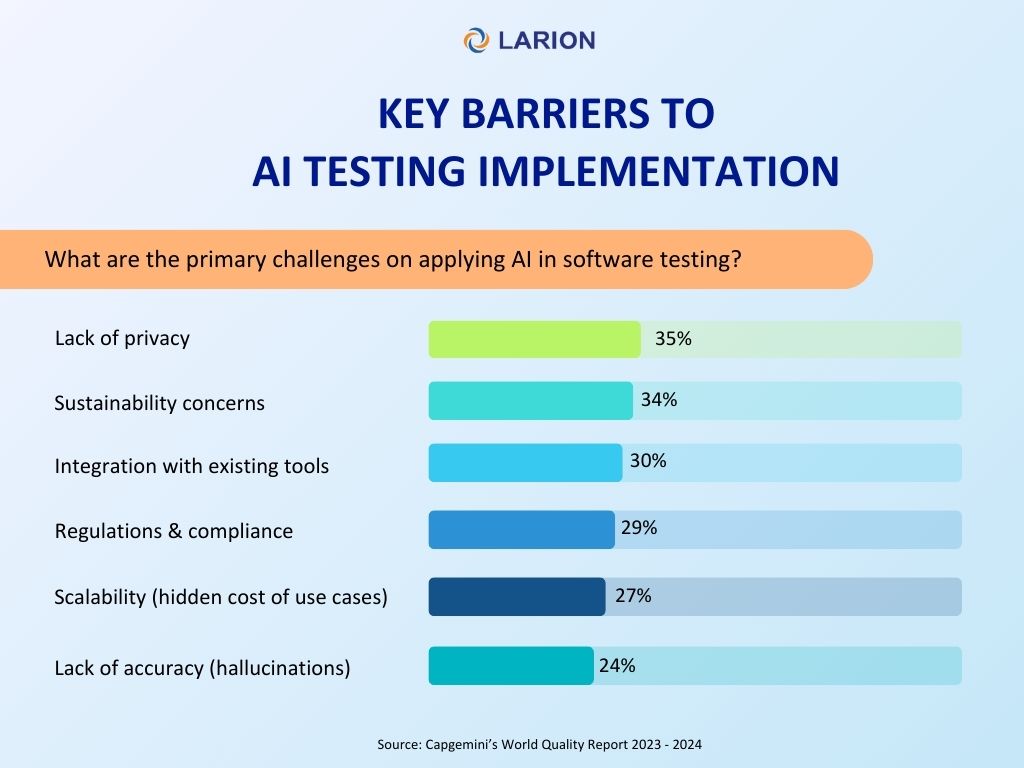The rapid release of software development and growing user demand have placed immense pressure on software testing to deliver high-quality products at an unprecedented pace. This led to the transition from manual to automated testing to accelerate the development cycle. However, automation also had its limitations with some automated tools requiring long configurations and a considerable amount of human intervention to improve the tools’ performance.
Now, the journey of test automation has entered an exciting new phase: Artificial Intelligence (AI). According to Capgemini’s World Quality Report, 77% of organizations are consistently adopting AI in software testing to optimize their QA processes. Many leverage the technology to enhance the reliability of tests (be it rooting out stale tests or self-healing automated tests) and minimize defects (defect analysis, defect prediction, risky code analysis, etc.)
In this article, we’ll delve into the world of AI testing, exploring how AI can optimize the testing process, its challenges, and providing practical AI prompts to streamline your QA workflows.
What is AI in the context of software testing?
AI in software testing involves assessing a system’s functionality, performance, and reliability incorporating artificial intelligence and machine learning algorithms. While it retains the fundamental techniques of traditional software testing (partially automated and partially manual), these methods have been significantly enhanced by AI technology.
With machine learning models, AI testing can analyze vast amounts of test data, create optimized test cases, and detect patterns that might indicate defects. Moreover, it can automatically adapt to software changes, enabling continuous testing and minimizing manual effort. This flexibility is particularly valuable in agile and DevOps environments, where rapid development cycles and continuous integration are key.
How to use AI in software testing
Among the AI techniques used in automation testing, machine learning, natural language processing, and computer vision are particularly notable for their robust capabilities and wide-ranging applications.
Machine Learning (ML)
Machine learning is the process of training algorithms to learn from historical data and make predictions or decisions without being explicitly programmed
Applications in testing
- Test case generation
AI test generators analyze historical test data and user behavior to automatically generate test cases. Testers can simply provide a plain language prompt instructing the AI to create a test for a specific scenario within seconds.
The key is problem formulation—clearly defining the focus, scope, and boundaries of the test to guide the AI in generating accurate test cases. Over time, as the AI learns more about user behavior in your application under test (AUT), it can adapt its test generation to align with your specific business needs.
- Defect prediction
By examining historical defect data, machine learning models can identify areas of the application that are most likely to have defects, prioritize issues and schedule defect resolution based on factors such as severity, impact, and criticality. This helps testing teams concentrate their efforts on critical areas, ensuring that defect resolution is managed effectively.
- Synthetic data creation
Companies can also leverage ML algorithms to analyze existing data sets, uncover underlying patterns and relationships, and create synthetic data that mirrors real-world scenarios. This data replicates diverse user behavior, edge cases, and system interactions, making it useful for software testing while alleviating concerns about data privacy and security compliance.
- Regression Automation
AI-powered tools can help in identifying and running test cases that are likely to be affected by recent code changes, ensuring that new updates don’t introduce new defects.
- Self-Healing Automation
This technique empowers test scripts to automatically adapt and recover from failures. By leveraging machine learning algorithms, these scripts can identify the root causes of test failures and take corrective actions. Hence, enhancing test resilience and limiting false positives
Natural Language Processing (NLP)
Natural language processing is a field of AI that allows machines to understand, interpret, and generate human language
Applications in testing
- Requirement Analysis
NLP tools can transform natural language requirements into formal user stories and test cases, ensuring comprehensive test coverage and minimizing the risk of misinterpretation.
- Defect Triage
NLP can examine bug reports and classify defects based on their descriptions, simplifying the process of prioritizing and managing them.
Computer vision
Computer vision is an AI field that enables computers to interpret and make decisions based on visual data.
Applications in Testing:
- Visual Testing
Computer vision algorithms analyze screenshots and UI elements to identify visual discrepancies, ensuring the application appears and functions correctly across various devices and screen sizes.
- UI Validation
Validate the user interface by using computer vision to interact with visual elements and verify that the UI reacts correctly to user input.
Benefits of AI in software testing
Increased Speed and Efficiency
Equipped with advanced capabilities, these AI-driven tools can drastically reduce the time required for test execution and lessens the maintenance burden by automatically updating test scripts as applications evolve. Moreover, AI enhances test coverage by intelligently identifying critical areas of an application and prioritizing test cases to ensure thorough and comprehensive testing. This combination of faster execution, reduced maintenance, and improved coverage makes AI testing a powerful asset for companies striving for efficiency and speed in their software development processes.
Enhanced test quality
AI-powered testing tools improve test result quality by cutting down on human error and utilizing predictive analytics to uncover potential issues. They can also examine past test data to predict software areas that might fail, allowing for more targeted testing efforts. This approach enhances defect detection reliability and reduces the likelihood of releasing software with hidden bugs.
Improved customer experience
As AI-based testing can rapidly detect and resolve issues that might otherwise go unnoticed, it greatly enhances the customer experience with smooth interactions and minimizes glitches. Additionally, AI’s ability to analyze user feedback and adapt testing processes means that products can be refined and optimized continuously
Challenges and Considerations of AI in Software Testing
Lack of privacy & regulations compliance
AI in software testing often involves handling large datasets, which can include sensitive or personally identifiable information (PII). Consequently, organizations using off-the-shelf AI testing tools have expressed concerns about the security measures in place within AI testing environments, particularly regarding data storage and transmission, to prevent unauthorized access and mitigate the risk of data breaches.
For organizations developing their own AI models, the challenge lies in navigating various regulations and compliance requirements, including data privacy, protection, and industry-specific regulations, which vary depending on the country of operation.
Sustainability concerns
AI-based testing is computationally intensive and demands substantial hardware, such as GPUs and data centers, which in turn require significant energy resources. The expansion of data centers, energy infrastructure, and hardware production has increased the demand for carbon-intensive raw materials like aluminum, silicon, plastic, and copper.
Additionally, data centers consume large amounts of water to cool their systems and prevent server overheating. A recent study estimated that each ChatGPT conversation involving 20-50 questions results in the consumption of about 500 milliliters of water at a data center.
Thus, these factors are particularly worth considering for sustainability-focused companies that prioritize corporate social responsibility (CSR) initiatives.
Integration with existing tools
Integrating AI automation testing tools with existing systems can present several challenges, primarily due to compatibility issues and configuration complexity. Often, the integration process involves using APIs or SDKs, which may not be compatible with all systems, potentially leading to technical difficulties and time-consuming
Furthermore, introducing AI testing tools into established workflows may necessitate changes to existing processes and practices, further complicating the transition. Furthermore, the integration may demand specialized technical skills and expertise, which might not be readily available within the organization, adding another layer of complexity to the implementation process.
Bias problems
AI models, when trained on limited or biased datasets, may generate unreliable or erroneous outputs. This can lead to the generation of hallucinations, where the model produces outputs that are inconsistent with reality.
The presence of data noise—such as errors or inconsistencies within the training data—can further exacerbate the problem by causing the model to learn incorrect patterns and make inaccurate predictions
AI Prompt Templates for QA Teams
Here are some practical AI prompts that can be useful for testers:
Test Scenario Generation (Basic)
Act as an expert software tester specializing in testing <> applications.
Develop test scenarios for testing the <> feature of the <> product.
Write the test scenarios in a story-like format.
Refer to the attached screenshot of the Application Feature Page for guidance.
Cover scenarios for positive cases, negative cases, and exploratory testing cases.
Test Scenarios Generated from Requirement (Advanced)
I want you to act as an expert software tester tasked with creating test scenarios for your team.
Generate comprehensive test scenarios based on the requirements provided below.
Ensure coverage of edge cases, positive and negative scenarios, as well as cases that are commonly overlooked by testers.
Additionally, provide a checklist of potential bugs that could arise during the implementation of the feature.
Here are the feature requirements:
Bug Reporting & Drafting
Act as an expert software tester responsible for drafting bug reports.
I want you to draft comprehensive bug reports based on the issue descriptions I will provide.
Your reports should be compelling and influential to encourage programmers to address the bugs effectively.
Each bug report should follow this format:
- Bug Title: A concise, impactful summary of the bug, under 12 words.
#Bug Description: Provide a clear and specific description of the bug, including why it is an issue. Aim for at least 2-3 lines
#Application Version:
#Test Environment Details: Specify the browser (e.g., Edge (Chromium)) and the installed version of the browser.
#Screenshot: [User will attach a screenshot here.]
#Consistently Producible: Indicate if the bug can be reproduced consistently (e.g., Yes, Thrice).
#Severity: Assign a severity level (High, Medium, Low, or Lowest).
#Impact to User: Describe how this bug affects the end user.
#Risks to Business: Explain the potential business risks associated with this bug.
#Additional Notes: Mention any severe side effects that may arise from this issue and why it is significant.
#Bug Re-Testing Ideas: Suggest a couple of testing ideas for the developer to use after fixing the bug in their local version.
#Similar Bugs Stories: Include any relevant stories of similar bugs that have gained global attention, if applicable.
Feel free to ask me for any clarifications needed to draft the bug reports. I need you to draft a clear and well-structured bug report
Here is the bug description to report:
Test data
I want you to act as an expert software tester who works on creating test data to provide comprehensive test data coverage.
Generate positive, negative, creative, big, little, invalid, exploratory, boundary-related, and penetration testing related test data to expose vulnerabilities.
Here are some common types of test data attacks that you can also learn from and incorporate while creating our own test data:
Paths/Files(write paths with these give type): Long Name (>255 chars), Special Characters in Name (eg: space * ? / \ | < > , . ( ) [ ] { } ; : ‘ “ ! @ # $ % ^ & ƒ ), Non-Existent characters, Characters with No Space.
Time and Date: Crossing Time Zones, Leap Days, Always Invalid Days (Feb 30, Sept 31), Feb 29 in Non-Leap Years, Different Formats (June 5, 2001; 06/05/2001; 06/05/01; 06-05-01; 6/5/2001 12:34), Internationalisation dd.mm.yyyy, mm/dd/yyyy, am/pm, Daylight Savings Changeover.
Numbers: 0, 32768 (215), 32769 (215 + 1), 65536 (216), 65537 (216 +1), 2147483648 (231), 2147483649 (231 + 1), 4294967296 (232), 4294967297 (232 + 1), Scientific Notation (1E-16), Negative, Floating Point/Decimal (0.0001), With Commas (1,234,567), European Style (1.234.567,89).
Strings: Long (255, 256, 257, 1000, 1024, 2000, 2048 or more characters), Accented Chars (àáâãäåçèéêëìíîðñòôõöö, etc.), Asian Characters
Common Delimiters and Special Characters ( “ ‘ ` | / \ , ; : & < > ^ * ? Tab ), Leave Blank, Single Space, Multiple Spaces, Leading Spaces, SQL Injection ( ‘select * from customer), Emojis
Provide the results in tabular format.
I want you to generate {10} rows of test data for: {}
These are the variable names to create test data for:
Requirement Analysis
I want you to act as an expert software tester involved in reviewing requirements and participating in requirement refinement meetings with the product team.
As a tester, your role is to assess whether each requirement is testable. If a requirement is not testable, please identify what changes are necessary to make it testable.
Additionally, for each requirement, provide comments as Questions, Notes, Risks, Test Ideas, and Requirement Bugs.
Here is the requirement for this feature:
Conclusion
With the current advancements in automated test case generation, synthetic data creation, self-healing, and defect detection, AI is poised to enhance the efficiency, accuracy and scalability of QA automation.
As technology continues to evolve, it is expected to introduce even more sophisticated capabilities, prompting more organizations to invest in it to scale their quality engineering processes, skills, and resources.
However, successfully implementing AI automation testing will require careful consideration, effective implementation strategies along with clear KPIs to overcome challenges such as data privacy, regulations compliance, sustainability concerns, tool integration and hallucinations.
With over 20 years of experience in revolutionizing software testing processes, our experts are well-equipped to guide you through the complexities of AI testing adoption and ensure that your testing processes are optimized for success. Let us leverage our extensive knowledge to support your goals and drive impactful results. Book a consultation with us today to start your journey towards enhanced software quality and performance.








